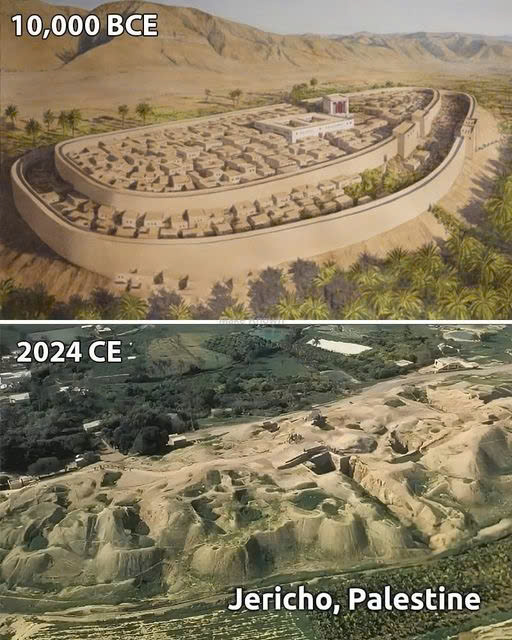Jericho, located in the heart of the West Bank, holds a unique distinction in the annals of human history as one of the world’s oldest continuously inhabited settlements. Its story begins around 9000 BC, marking the dawn of organized human civilization. This ancient town has witnessed and adapted to countless transformations, offering unparalleled insights into the evolution of human society.
Around 8000 BC, Jericho’s residents accomplished an extraordinary feat by constructing a massive stone wall encircling their settlement. This wall wasn’t merely a physical barrier—it symbolized a groundbreaking shift in human ingenuity. Standing tall with an imposing stone fortification, it reflected a profound transition in human lifestyle. The construction of this structure signaled humanity’s move away from nomadic existence to a more settled agricultural life. It wasn’t just a defense mechanism; it was an engineering marvel that demonstrated a community’s ability to collaborate and innovate.

The people of Jericho were pioneers in the agricultural revolution, fundamentally transforming human history. Archaeological discoveries in the region have revealed cultivated grains of wheat and barley, clear evidence of their early farming practices. It is highly likely that these ancient inhabitants developed primitive irrigation techniques to sustain their crops in the challenging environment. Their ability to harness the land for sustenance laid the foundation for settled communities and marked a significant turning point in human development.
However, Jericho’s journey through time was far from linear. Around 7000 BC, a new Neolithic culture emerged in the town, characterized by a fascinating absence of pottery. Known as the “Pottery-less Period,” this era represents a distinct cultural shift. This phase persisted until approximately 6000 BC, after which the town experienced a millennium of sparse habitation. Despite this lull, Jericho’s story was far from over.
The city underwent a remarkable rebirth at the end of the 4th millennium BC when it reemerged as a walled urban center. This resurgence, however, was short-lived. By 2300 BC, nomadic groups—possibly the Amorites—once again disrupted the urban way of life, forcing the city into decline. It wasn’t until the arrival of the Canaanites around 1900 BC that Jericho reclaimed its status as a thriving urban settlement. Archaeological evidence from this period reveals a glimpse into the daily lives of the Canaanites, showcasing their domestic culture and urban sophistication.
Jericho’s role in biblical history further cements its place in human memory. One of its most iconic stories is the dramatic conquest by the Israelites under Joshua, a pivotal event described in the Old Testament. According to biblical accounts, the walls of Jericho famously “came tumbling down” during this conquest, leading to the city’s abandonment. It remained uninhabited for centuries before being resettled, adding another layer of complexity to its narrative.
The story of Jericho took a grand turn during the reign of Herod the Great, who chose the town as the site for his winter residence. Recent archaeological excavations have uncovered remnants of Herodian Jericho, including what is believed to be part of Herod’s magnificent palace near the Wadi Al-Qilṭ. This discovery highlights the opulence of Herod’s era and underscores Jericho’s enduring significance as a place of political and cultural importance.
Jericho’s history is also marked by its distinct geographic evolution. Over the millennia, the town has occupied three separate sites, each representing a different era. The Old Testament town, celebrated for its biblical significance, stood at one location. About a mile south of this original site lies the Roman and New Testament city, reflecting the town’s prominence during the Roman Empire. A mile east of the Old Testament location is the Crusader-era settlement, which later gave rise to modern Jericho. Today’s Jericho, thriving at this third site, serves as a testament to the resilience and adaptability of this ancient city.
Modern Jericho continues to thrive, carrying forward the legacy of one of the world’s oldest continuously inhabited cities. Its layers of history, from the dawn of civilization to biblical events and Herodian grandeur, offer a remarkable glimpse into humanity’s journey through time. Jericho is more than an archaeological treasure—it is a living symbol of human endurance, innovation, and cultural evolution.





